Failure of Teamwork to Achieve Patient-Centered Care: Case Study
VerifiedAdded on 2020/05/28
|12
|3237
|64
Case Study
AI Summary
This case study analyzes the failure of a multidisciplinary healthcare team at Bloomsvalley Nursing Home to provide person-centered care to a 68-year-old patient, Samandra Jones, leading to her readmission and other sufferings. The study highlights critical issues such as autocratic leadership, lack of communication and motivation among team members, trust issues, blame games, and the absence of conflict resolution skills. These failures resulted in a lack of coordinated care, inadequate patient involvement, and ultimately, a negative impact on the patient's well-being and her family. The case study explores the reasons behind the teamwork breakdown, emphasizing the need for improved planning, decision-making, problem-solving, and conflict resolution skills within healthcare teams to ensure effective patient-centered care and positive health outcomes.
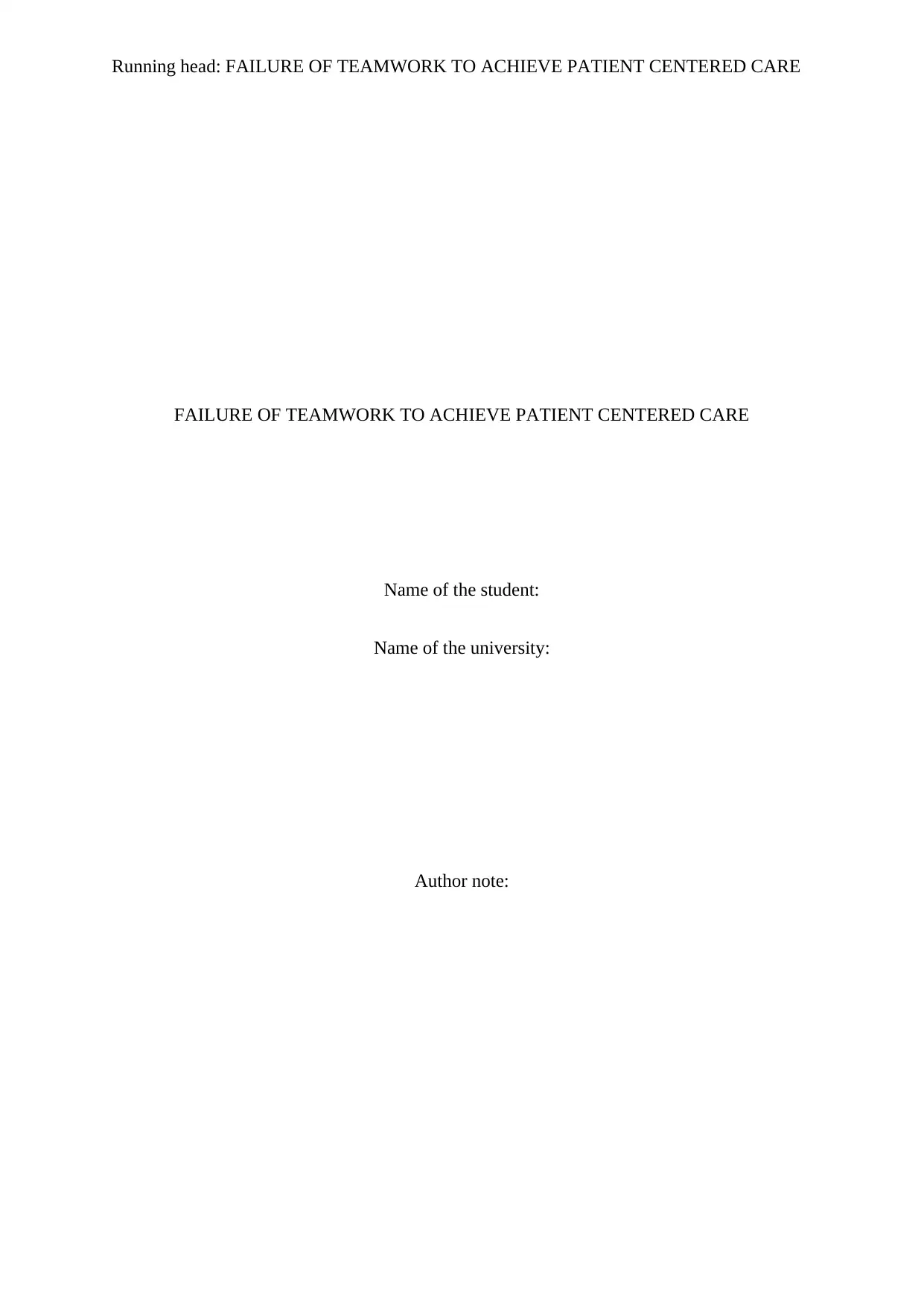
Running head: FAILURE OF TEAMWORK TO ACHIEVE PATIENT CENTERED CARE
FAILURE OF TEAMWORK TO ACHIEVE PATIENT CENTERED CARE
Name of the student:
Name of the university:
Author note:
FAILURE OF TEAMWORK TO ACHIEVE PATIENT CENTERED CARE
Name of the student:
Name of the university:
Author note:
Paraphrase This Document
Need a fresh take? Get an instant paraphrase of this document with our AI Paraphraser
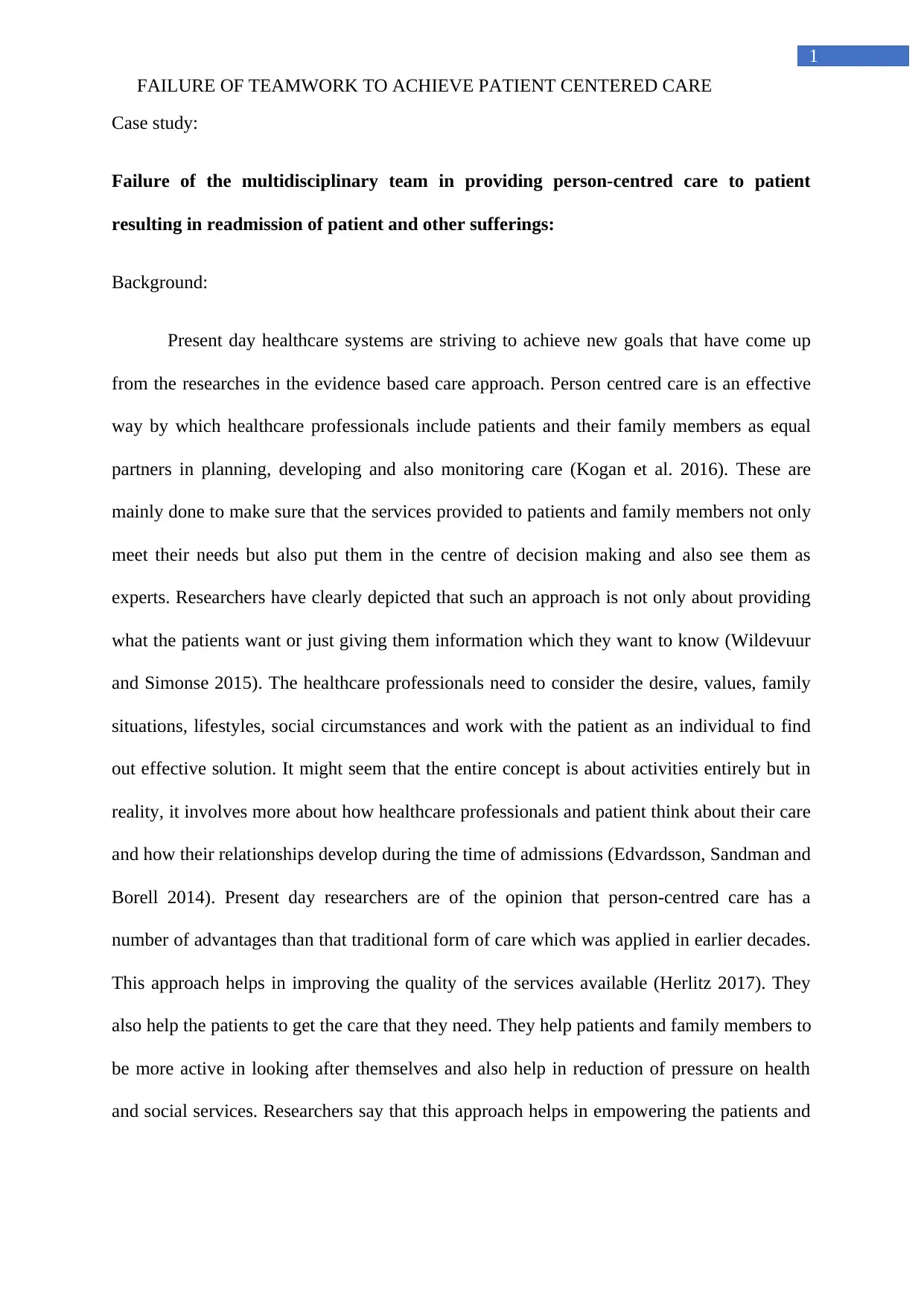
1
FAILURE OF TEAMWORK TO ACHIEVE PATIENT CENTERED CARE
Case study:
Failure of the multidisciplinary team in providing person-centred care to patient
resulting in readmission of patient and other sufferings:
Background:
Present day healthcare systems are striving to achieve new goals that have come up
from the researches in the evidence based care approach. Person centred care is an effective
way by which healthcare professionals include patients and their family members as equal
partners in planning, developing and also monitoring care (Kogan et al. 2016). These are
mainly done to make sure that the services provided to patients and family members not only
meet their needs but also put them in the centre of decision making and also see them as
experts. Researchers have clearly depicted that such an approach is not only about providing
what the patients want or just giving them information which they want to know (Wildevuur
and Simonse 2015). The healthcare professionals need to consider the desire, values, family
situations, lifestyles, social circumstances and work with the patient as an individual to find
out effective solution. It might seem that the entire concept is about activities entirely but in
reality, it involves more about how healthcare professionals and patient think about their care
and how their relationships develop during the time of admissions (Edvardsson, Sandman and
Borell 2014). Present day researchers are of the opinion that person-centred care has a
number of advantages than that traditional form of care which was applied in earlier decades.
This approach helps in improving the quality of the services available (Herlitz 2017). They
also help the patients to get the care that they need. They help patients and family members to
be more active in looking after themselves and also help in reduction of pressure on health
and social services. Researchers say that this approach helps in empowering the patients and
FAILURE OF TEAMWORK TO ACHIEVE PATIENT CENTERED CARE
Case study:
Failure of the multidisciplinary team in providing person-centred care to patient
resulting in readmission of patient and other sufferings:
Background:
Present day healthcare systems are striving to achieve new goals that have come up
from the researches in the evidence based care approach. Person centred care is an effective
way by which healthcare professionals include patients and their family members as equal
partners in planning, developing and also monitoring care (Kogan et al. 2016). These are
mainly done to make sure that the services provided to patients and family members not only
meet their needs but also put them in the centre of decision making and also see them as
experts. Researchers have clearly depicted that such an approach is not only about providing
what the patients want or just giving them information which they want to know (Wildevuur
and Simonse 2015). The healthcare professionals need to consider the desire, values, family
situations, lifestyles, social circumstances and work with the patient as an individual to find
out effective solution. It might seem that the entire concept is about activities entirely but in
reality, it involves more about how healthcare professionals and patient think about their care
and how their relationships develop during the time of admissions (Edvardsson, Sandman and
Borell 2014). Present day researchers are of the opinion that person-centred care has a
number of advantages than that traditional form of care which was applied in earlier decades.
This approach helps in improving the quality of the services available (Herlitz 2017). They
also help the patients to get the care that they need. They help patients and family members to
be more active in looking after themselves and also help in reduction of pressure on health
and social services. Researchers say that this approach helps in empowering the patients and
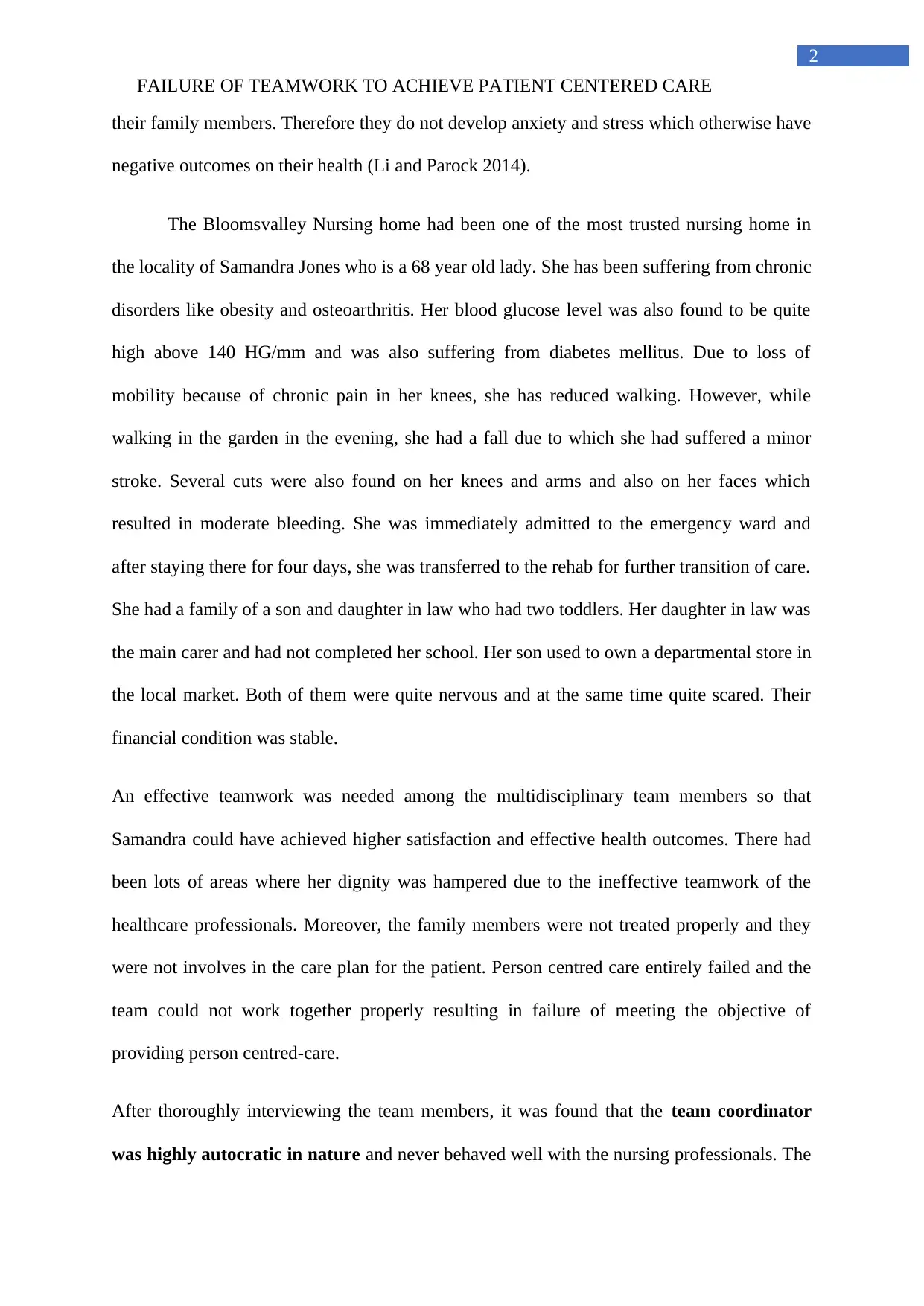
2
FAILURE OF TEAMWORK TO ACHIEVE PATIENT CENTERED CARE
their family members. Therefore they do not develop anxiety and stress which otherwise have
negative outcomes on their health (Li and Parock 2014).
The Bloomsvalley Nursing home had been one of the most trusted nursing home in
the locality of Samandra Jones who is a 68 year old lady. She has been suffering from chronic
disorders like obesity and osteoarthritis. Her blood glucose level was also found to be quite
high above 140 HG/mm and was also suffering from diabetes mellitus. Due to loss of
mobility because of chronic pain in her knees, she has reduced walking. However, while
walking in the garden in the evening, she had a fall due to which she had suffered a minor
stroke. Several cuts were also found on her knees and arms and also on her faces which
resulted in moderate bleeding. She was immediately admitted to the emergency ward and
after staying there for four days, she was transferred to the rehab for further transition of care.
She had a family of a son and daughter in law who had two toddlers. Her daughter in law was
the main carer and had not completed her school. Her son used to own a departmental store in
the local market. Both of them were quite nervous and at the same time quite scared. Their
financial condition was stable.
An effective teamwork was needed among the multidisciplinary team members so that
Samandra could have achieved higher satisfaction and effective health outcomes. There had
been lots of areas where her dignity was hampered due to the ineffective teamwork of the
healthcare professionals. Moreover, the family members were not treated properly and they
were not involves in the care plan for the patient. Person centred care entirely failed and the
team could not work together properly resulting in failure of meeting the objective of
providing person centred-care.
After thoroughly interviewing the team members, it was found that the team coordinator
was highly autocratic in nature and never behaved well with the nursing professionals. The
FAILURE OF TEAMWORK TO ACHIEVE PATIENT CENTERED CARE
their family members. Therefore they do not develop anxiety and stress which otherwise have
negative outcomes on their health (Li and Parock 2014).
The Bloomsvalley Nursing home had been one of the most trusted nursing home in
the locality of Samandra Jones who is a 68 year old lady. She has been suffering from chronic
disorders like obesity and osteoarthritis. Her blood glucose level was also found to be quite
high above 140 HG/mm and was also suffering from diabetes mellitus. Due to loss of
mobility because of chronic pain in her knees, she has reduced walking. However, while
walking in the garden in the evening, she had a fall due to which she had suffered a minor
stroke. Several cuts were also found on her knees and arms and also on her faces which
resulted in moderate bleeding. She was immediately admitted to the emergency ward and
after staying there for four days, she was transferred to the rehab for further transition of care.
She had a family of a son and daughter in law who had two toddlers. Her daughter in law was
the main carer and had not completed her school. Her son used to own a departmental store in
the local market. Both of them were quite nervous and at the same time quite scared. Their
financial condition was stable.
An effective teamwork was needed among the multidisciplinary team members so that
Samandra could have achieved higher satisfaction and effective health outcomes. There had
been lots of areas where her dignity was hampered due to the ineffective teamwork of the
healthcare professionals. Moreover, the family members were not treated properly and they
were not involves in the care plan for the patient. Person centred care entirely failed and the
team could not work together properly resulting in failure of meeting the objective of
providing person centred-care.
After thoroughly interviewing the team members, it was found that the team coordinator
was highly autocratic in nature and never behaved well with the nursing professionals. The
⊘ This is a preview!⊘
Do you want full access?
Subscribe today to unlock all pages.

Trusted by 1+ million students worldwide
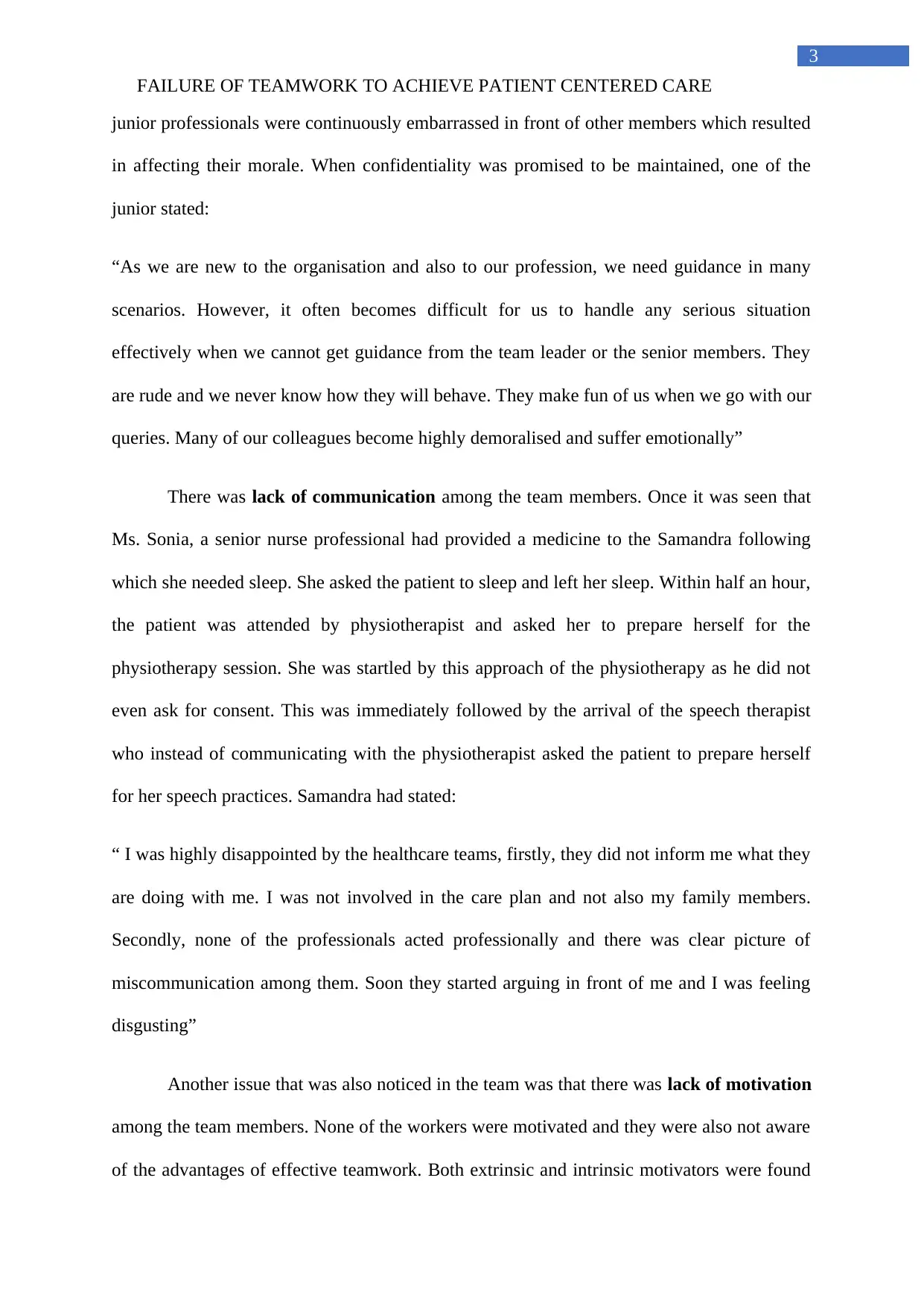
3
FAILURE OF TEAMWORK TO ACHIEVE PATIENT CENTERED CARE
junior professionals were continuously embarrassed in front of other members which resulted
in affecting their morale. When confidentiality was promised to be maintained, one of the
junior stated:
“As we are new to the organisation and also to our profession, we need guidance in many
scenarios. However, it often becomes difficult for us to handle any serious situation
effectively when we cannot get guidance from the team leader or the senior members. They
are rude and we never know how they will behave. They make fun of us when we go with our
queries. Many of our colleagues become highly demoralised and suffer emotionally”
There was lack of communication among the team members. Once it was seen that
Ms. Sonia, a senior nurse professional had provided a medicine to the Samandra following
which she needed sleep. She asked the patient to sleep and left her sleep. Within half an hour,
the patient was attended by physiotherapist and asked her to prepare herself for the
physiotherapy session. She was startled by this approach of the physiotherapy as he did not
even ask for consent. This was immediately followed by the arrival of the speech therapist
who instead of communicating with the physiotherapist asked the patient to prepare herself
for her speech practices. Samandra had stated:
“ I was highly disappointed by the healthcare teams, firstly, they did not inform me what they
are doing with me. I was not involved in the care plan and not also my family members.
Secondly, none of the professionals acted professionally and there was clear picture of
miscommunication among them. Soon they started arguing in front of me and I was feeling
disgusting”
Another issue that was also noticed in the team was that there was lack of motivation
among the team members. None of the workers were motivated and they were also not aware
of the advantages of effective teamwork. Both extrinsic and intrinsic motivators were found
FAILURE OF TEAMWORK TO ACHIEVE PATIENT CENTERED CARE
junior professionals were continuously embarrassed in front of other members which resulted
in affecting their morale. When confidentiality was promised to be maintained, one of the
junior stated:
“As we are new to the organisation and also to our profession, we need guidance in many
scenarios. However, it often becomes difficult for us to handle any serious situation
effectively when we cannot get guidance from the team leader or the senior members. They
are rude and we never know how they will behave. They make fun of us when we go with our
queries. Many of our colleagues become highly demoralised and suffer emotionally”
There was lack of communication among the team members. Once it was seen that
Ms. Sonia, a senior nurse professional had provided a medicine to the Samandra following
which she needed sleep. She asked the patient to sleep and left her sleep. Within half an hour,
the patient was attended by physiotherapist and asked her to prepare herself for the
physiotherapy session. She was startled by this approach of the physiotherapy as he did not
even ask for consent. This was immediately followed by the arrival of the speech therapist
who instead of communicating with the physiotherapist asked the patient to prepare herself
for her speech practices. Samandra had stated:
“ I was highly disappointed by the healthcare teams, firstly, they did not inform me what they
are doing with me. I was not involved in the care plan and not also my family members.
Secondly, none of the professionals acted professionally and there was clear picture of
miscommunication among them. Soon they started arguing in front of me and I was feeling
disgusting”
Another issue that was also noticed in the team was that there was lack of motivation
among the team members. None of the workers were motivated and they were also not aware
of the advantages of effective teamwork. Both extrinsic and intrinsic motivators were found
Paraphrase This Document
Need a fresh take? Get an instant paraphrase of this document with our AI Paraphraser
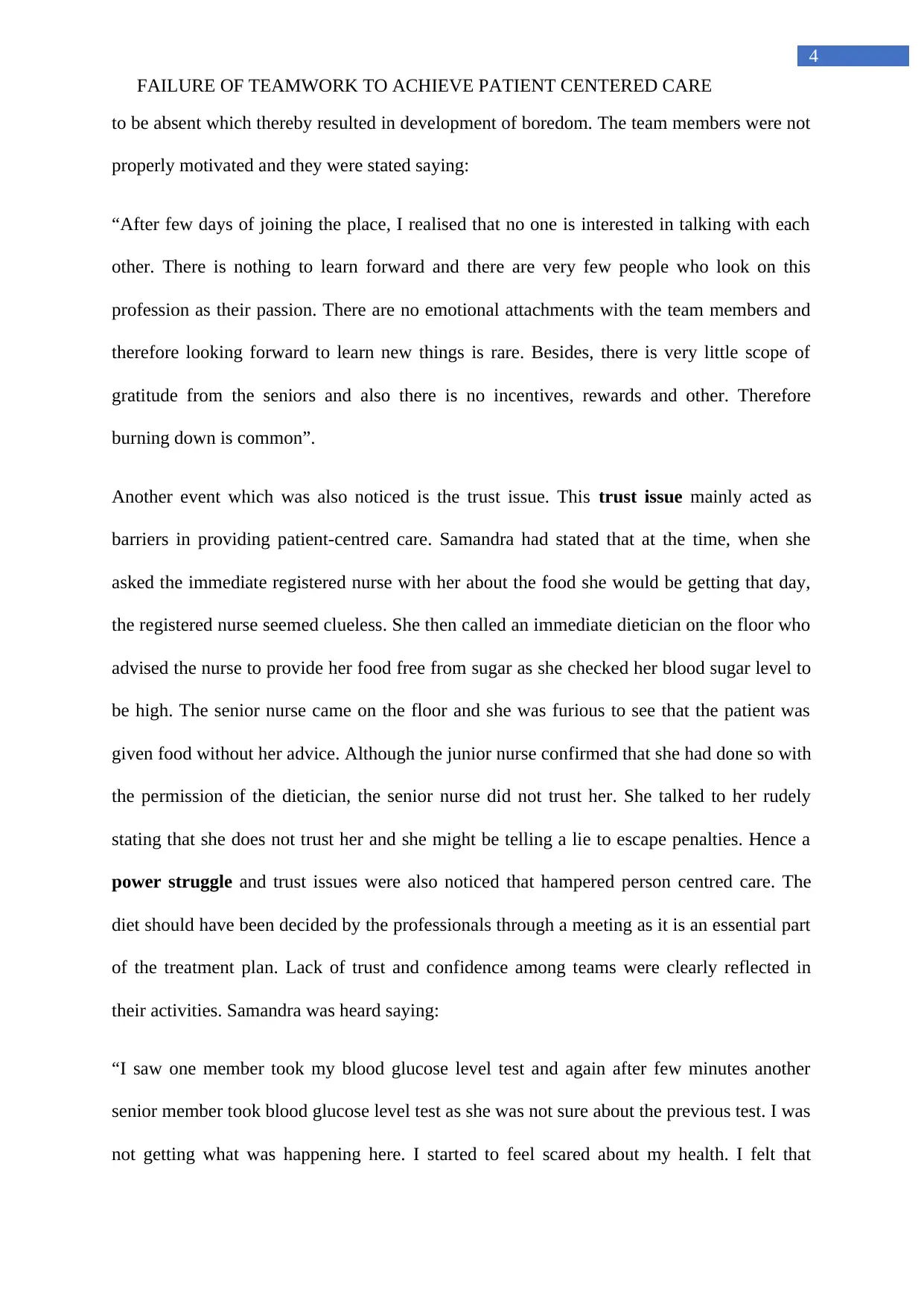
4
FAILURE OF TEAMWORK TO ACHIEVE PATIENT CENTERED CARE
to be absent which thereby resulted in development of boredom. The team members were not
properly motivated and they were stated saying:
“After few days of joining the place, I realised that no one is interested in talking with each
other. There is nothing to learn forward and there are very few people who look on this
profession as their passion. There are no emotional attachments with the team members and
therefore looking forward to learn new things is rare. Besides, there is very little scope of
gratitude from the seniors and also there is no incentives, rewards and other. Therefore
burning down is common”.
Another event which was also noticed is the trust issue. This trust issue mainly acted as
barriers in providing patient-centred care. Samandra had stated that at the time, when she
asked the immediate registered nurse with her about the food she would be getting that day,
the registered nurse seemed clueless. She then called an immediate dietician on the floor who
advised the nurse to provide her food free from sugar as she checked her blood sugar level to
be high. The senior nurse came on the floor and she was furious to see that the patient was
given food without her advice. Although the junior nurse confirmed that she had done so with
the permission of the dietician, the senior nurse did not trust her. She talked to her rudely
stating that she does not trust her and she might be telling a lie to escape penalties. Hence a
power struggle and trust issues were also noticed that hampered person centred care. The
diet should have been decided by the professionals through a meeting as it is an essential part
of the treatment plan. Lack of trust and confidence among teams were clearly reflected in
their activities. Samandra was heard saying:
“I saw one member took my blood glucose level test and again after few minutes another
senior member took blood glucose level test as she was not sure about the previous test. I was
not getting what was happening here. I started to feel scared about my health. I felt that
FAILURE OF TEAMWORK TO ACHIEVE PATIENT CENTERED CARE
to be absent which thereby resulted in development of boredom. The team members were not
properly motivated and they were stated saying:
“After few days of joining the place, I realised that no one is interested in talking with each
other. There is nothing to learn forward and there are very few people who look on this
profession as their passion. There are no emotional attachments with the team members and
therefore looking forward to learn new things is rare. Besides, there is very little scope of
gratitude from the seniors and also there is no incentives, rewards and other. Therefore
burning down is common”.
Another event which was also noticed is the trust issue. This trust issue mainly acted as
barriers in providing patient-centred care. Samandra had stated that at the time, when she
asked the immediate registered nurse with her about the food she would be getting that day,
the registered nurse seemed clueless. She then called an immediate dietician on the floor who
advised the nurse to provide her food free from sugar as she checked her blood sugar level to
be high. The senior nurse came on the floor and she was furious to see that the patient was
given food without her advice. Although the junior nurse confirmed that she had done so with
the permission of the dietician, the senior nurse did not trust her. She talked to her rudely
stating that she does not trust her and she might be telling a lie to escape penalties. Hence a
power struggle and trust issues were also noticed that hampered person centred care. The
diet should have been decided by the professionals through a meeting as it is an essential part
of the treatment plan. Lack of trust and confidence among teams were clearly reflected in
their activities. Samandra was heard saying:
“I saw one member took my blood glucose level test and again after few minutes another
senior member took blood glucose level test as she was not sure about the previous test. I was
not getting what was happening here. I started to feel scared about my health. I felt that
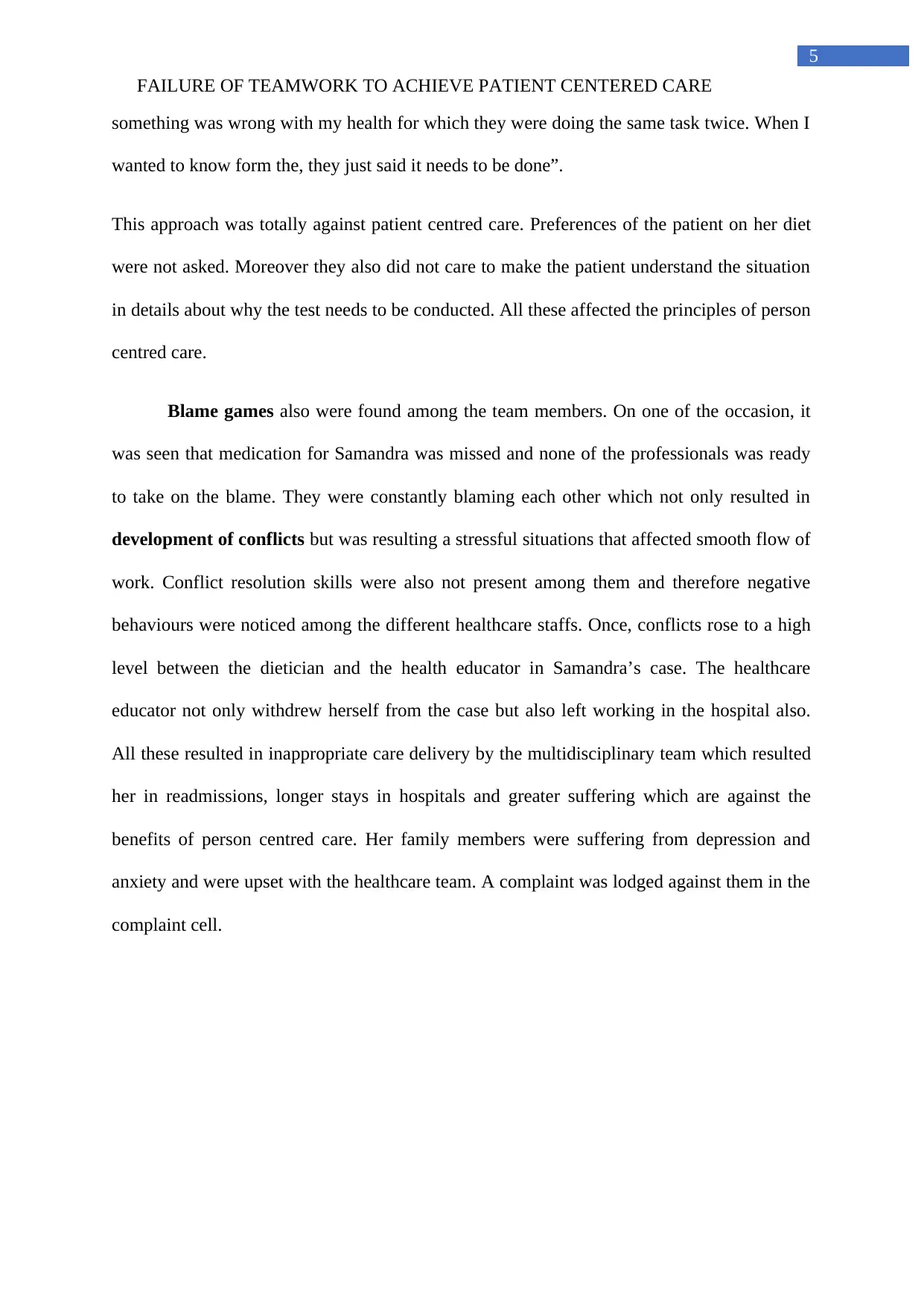
5
FAILURE OF TEAMWORK TO ACHIEVE PATIENT CENTERED CARE
something was wrong with my health for which they were doing the same task twice. When I
wanted to know form the, they just said it needs to be done”.
This approach was totally against patient centred care. Preferences of the patient on her diet
were not asked. Moreover they also did not care to make the patient understand the situation
in details about why the test needs to be conducted. All these affected the principles of person
centred care.
Blame games also were found among the team members. On one of the occasion, it
was seen that medication for Samandra was missed and none of the professionals was ready
to take on the blame. They were constantly blaming each other which not only resulted in
development of conflicts but was resulting a stressful situations that affected smooth flow of
work. Conflict resolution skills were also not present among them and therefore negative
behaviours were noticed among the different healthcare staffs. Once, conflicts rose to a high
level between the dietician and the health educator in Samandra’s case. The healthcare
educator not only withdrew herself from the case but also left working in the hospital also.
All these resulted in inappropriate care delivery by the multidisciplinary team which resulted
her in readmissions, longer stays in hospitals and greater suffering which are against the
benefits of person centred care. Her family members were suffering from depression and
anxiety and were upset with the healthcare team. A complaint was lodged against them in the
complaint cell.
FAILURE OF TEAMWORK TO ACHIEVE PATIENT CENTERED CARE
something was wrong with my health for which they were doing the same task twice. When I
wanted to know form the, they just said it needs to be done”.
This approach was totally against patient centred care. Preferences of the patient on her diet
were not asked. Moreover they also did not care to make the patient understand the situation
in details about why the test needs to be conducted. All these affected the principles of person
centred care.
Blame games also were found among the team members. On one of the occasion, it
was seen that medication for Samandra was missed and none of the professionals was ready
to take on the blame. They were constantly blaming each other which not only resulted in
development of conflicts but was resulting a stressful situations that affected smooth flow of
work. Conflict resolution skills were also not present among them and therefore negative
behaviours were noticed among the different healthcare staffs. Once, conflicts rose to a high
level between the dietician and the health educator in Samandra’s case. The healthcare
educator not only withdrew herself from the case but also left working in the hospital also.
All these resulted in inappropriate care delivery by the multidisciplinary team which resulted
her in readmissions, longer stays in hospitals and greater suffering which are against the
benefits of person centred care. Her family members were suffering from depression and
anxiety and were upset with the healthcare team. A complaint was lodged against them in the
complaint cell.
⊘ This is a preview!⊘
Do you want full access?
Subscribe today to unlock all pages.

Trusted by 1+ million students worldwide
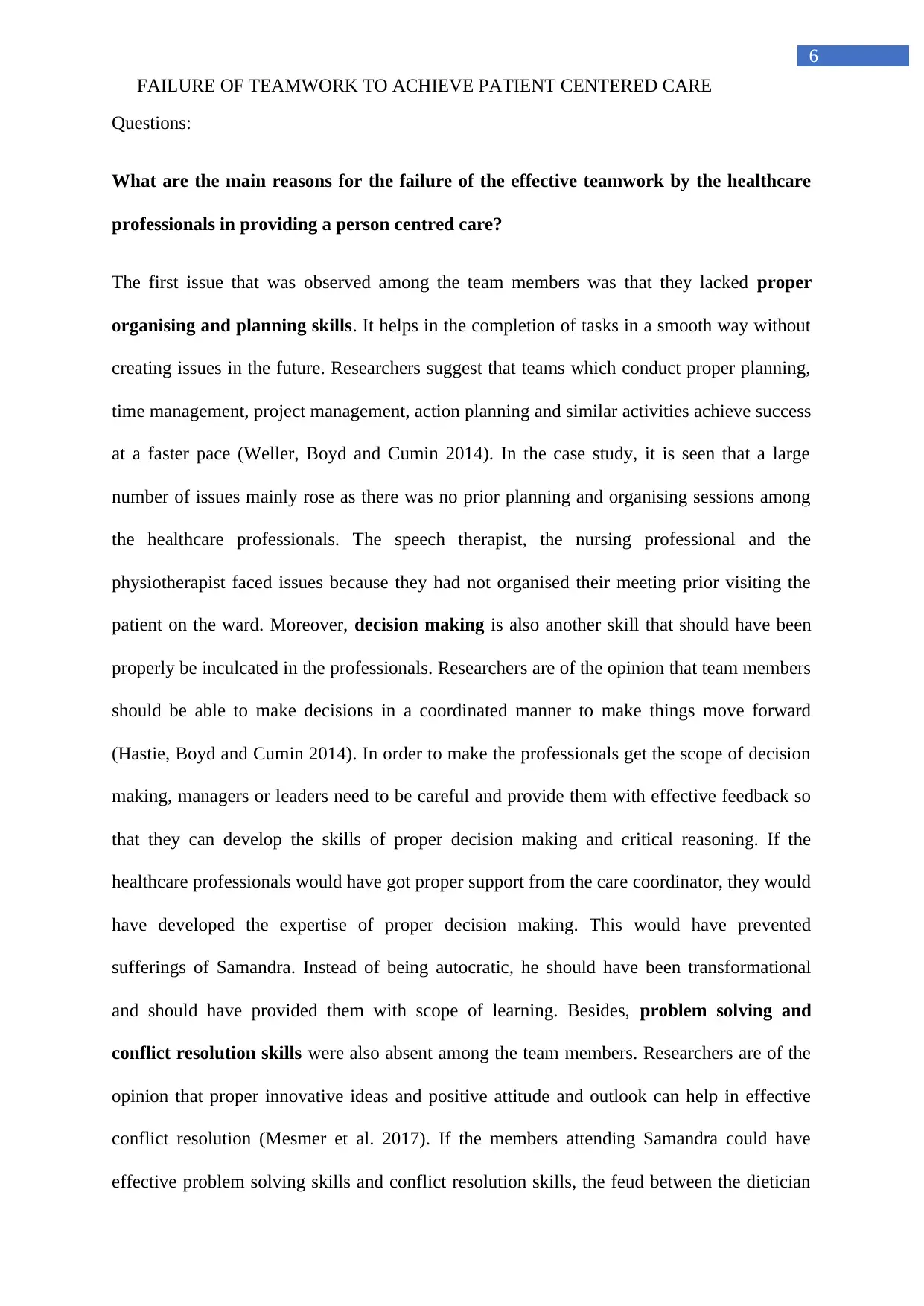
6
FAILURE OF TEAMWORK TO ACHIEVE PATIENT CENTERED CARE
Questions:
What are the main reasons for the failure of the effective teamwork by the healthcare
professionals in providing a person centred care?
The first issue that was observed among the team members was that they lacked proper
organising and planning skills. It helps in the completion of tasks in a smooth way without
creating issues in the future. Researchers suggest that teams which conduct proper planning,
time management, project management, action planning and similar activities achieve success
at a faster pace (Weller, Boyd and Cumin 2014). In the case study, it is seen that a large
number of issues mainly rose as there was no prior planning and organising sessions among
the healthcare professionals. The speech therapist, the nursing professional and the
physiotherapist faced issues because they had not organised their meeting prior visiting the
patient on the ward. Moreover, decision making is also another skill that should have been
properly be inculcated in the professionals. Researchers are of the opinion that team members
should be able to make decisions in a coordinated manner to make things move forward
(Hastie, Boyd and Cumin 2014). In order to make the professionals get the scope of decision
making, managers or leaders need to be careful and provide them with effective feedback so
that they can develop the skills of proper decision making and critical reasoning. If the
healthcare professionals would have got proper support from the care coordinator, they would
have developed the expertise of proper decision making. This would have prevented
sufferings of Samandra. Instead of being autocratic, he should have been transformational
and should have provided them with scope of learning. Besides, problem solving and
conflict resolution skills were also absent among the team members. Researchers are of the
opinion that proper innovative ideas and positive attitude and outlook can help in effective
conflict resolution (Mesmer et al. 2017). If the members attending Samandra could have
effective problem solving skills and conflict resolution skills, the feud between the dietician
FAILURE OF TEAMWORK TO ACHIEVE PATIENT CENTERED CARE
Questions:
What are the main reasons for the failure of the effective teamwork by the healthcare
professionals in providing a person centred care?
The first issue that was observed among the team members was that they lacked proper
organising and planning skills. It helps in the completion of tasks in a smooth way without
creating issues in the future. Researchers suggest that teams which conduct proper planning,
time management, project management, action planning and similar activities achieve success
at a faster pace (Weller, Boyd and Cumin 2014). In the case study, it is seen that a large
number of issues mainly rose as there was no prior planning and organising sessions among
the healthcare professionals. The speech therapist, the nursing professional and the
physiotherapist faced issues because they had not organised their meeting prior visiting the
patient on the ward. Moreover, decision making is also another skill that should have been
properly be inculcated in the professionals. Researchers are of the opinion that team members
should be able to make decisions in a coordinated manner to make things move forward
(Hastie, Boyd and Cumin 2014). In order to make the professionals get the scope of decision
making, managers or leaders need to be careful and provide them with effective feedback so
that they can develop the skills of proper decision making and critical reasoning. If the
healthcare professionals would have got proper support from the care coordinator, they would
have developed the expertise of proper decision making. This would have prevented
sufferings of Samandra. Instead of being autocratic, he should have been transformational
and should have provided them with scope of learning. Besides, problem solving and
conflict resolution skills were also absent among the team members. Researchers are of the
opinion that proper innovative ideas and positive attitude and outlook can help in effective
conflict resolution (Mesmer et al. 2017). If the members attending Samandra could have
effective problem solving skills and conflict resolution skills, the feud between the dietician
Paraphrase This Document
Need a fresh take? Get an instant paraphrase of this document with our AI Paraphraser
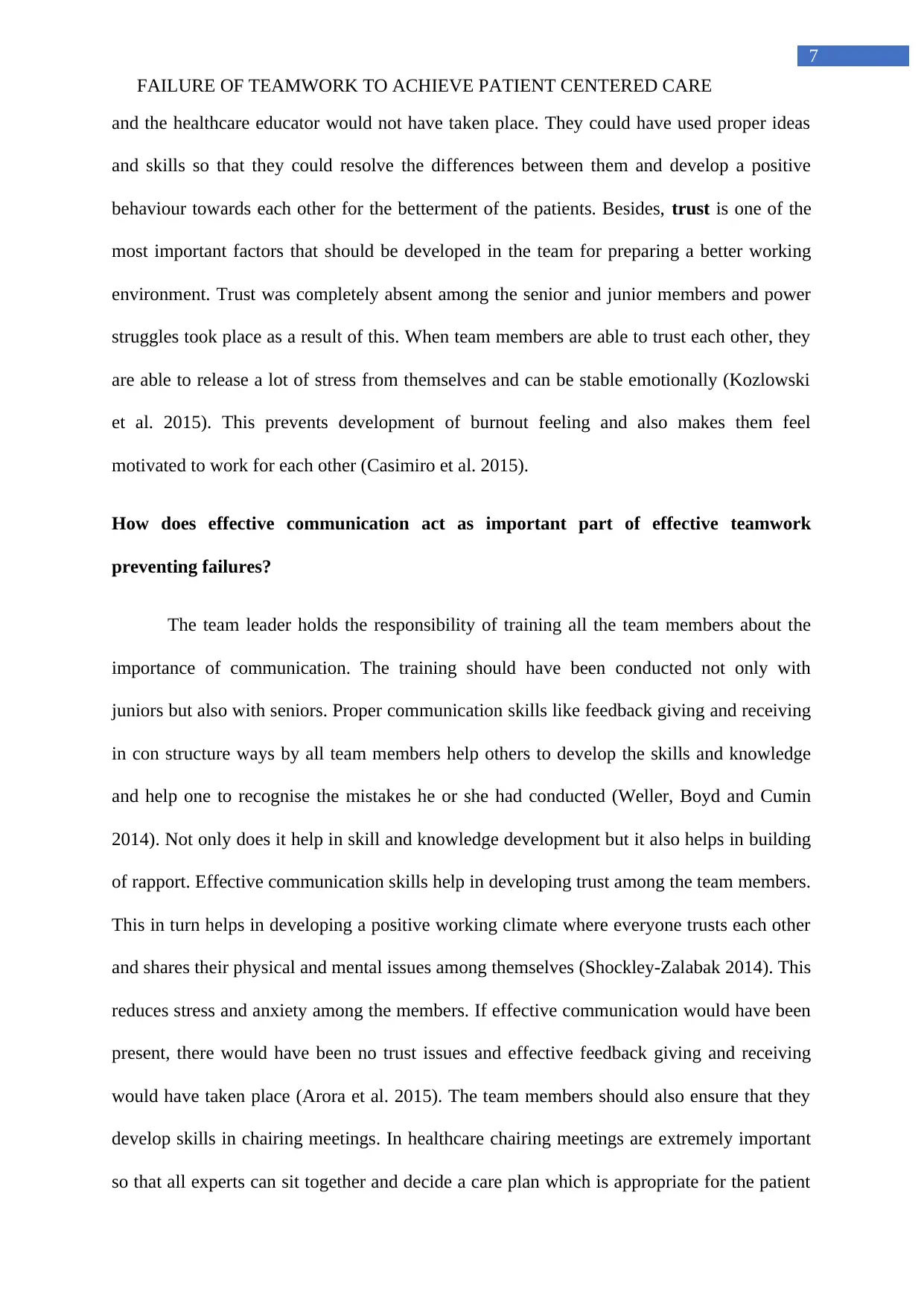
7
FAILURE OF TEAMWORK TO ACHIEVE PATIENT CENTERED CARE
and the healthcare educator would not have taken place. They could have used proper ideas
and skills so that they could resolve the differences between them and develop a positive
behaviour towards each other for the betterment of the patients. Besides, trust is one of the
most important factors that should be developed in the team for preparing a better working
environment. Trust was completely absent among the senior and junior members and power
struggles took place as a result of this. When team members are able to trust each other, they
are able to release a lot of stress from themselves and can be stable emotionally (Kozlowski
et al. 2015). This prevents development of burnout feeling and also makes them feel
motivated to work for each other (Casimiro et al. 2015).
How does effective communication act as important part of effective teamwork
preventing failures?
The team leader holds the responsibility of training all the team members about the
importance of communication. The training should have been conducted not only with
juniors but also with seniors. Proper communication skills like feedback giving and receiving
in con structure ways by all team members help others to develop the skills and knowledge
and help one to recognise the mistakes he or she had conducted (Weller, Boyd and Cumin
2014). Not only does it help in skill and knowledge development but it also helps in building
of rapport. Effective communication skills help in developing trust among the team members.
This in turn helps in developing a positive working climate where everyone trusts each other
and shares their physical and mental issues among themselves (Shockley-Zalabak 2014). This
reduces stress and anxiety among the members. If effective communication would have been
present, there would have been no trust issues and effective feedback giving and receiving
would have taken place (Arora et al. 2015). The team members should also ensure that they
develop skills in chairing meetings. In healthcare chairing meetings are extremely important
so that all experts can sit together and decide a care plan which is appropriate for the patient
FAILURE OF TEAMWORK TO ACHIEVE PATIENT CENTERED CARE
and the healthcare educator would not have taken place. They could have used proper ideas
and skills so that they could resolve the differences between them and develop a positive
behaviour towards each other for the betterment of the patients. Besides, trust is one of the
most important factors that should be developed in the team for preparing a better working
environment. Trust was completely absent among the senior and junior members and power
struggles took place as a result of this. When team members are able to trust each other, they
are able to release a lot of stress from themselves and can be stable emotionally (Kozlowski
et al. 2015). This prevents development of burnout feeling and also makes them feel
motivated to work for each other (Casimiro et al. 2015).
How does effective communication act as important part of effective teamwork
preventing failures?
The team leader holds the responsibility of training all the team members about the
importance of communication. The training should have been conducted not only with
juniors but also with seniors. Proper communication skills like feedback giving and receiving
in con structure ways by all team members help others to develop the skills and knowledge
and help one to recognise the mistakes he or she had conducted (Weller, Boyd and Cumin
2014). Not only does it help in skill and knowledge development but it also helps in building
of rapport. Effective communication skills help in developing trust among the team members.
This in turn helps in developing a positive working climate where everyone trusts each other
and shares their physical and mental issues among themselves (Shockley-Zalabak 2014). This
reduces stress and anxiety among the members. If effective communication would have been
present, there would have been no trust issues and effective feedback giving and receiving
would have taken place (Arora et al. 2015). The team members should also ensure that they
develop skills in chairing meetings. In healthcare chairing meetings are extremely important
so that all experts can sit together and decide a care plan which is appropriate for the patient
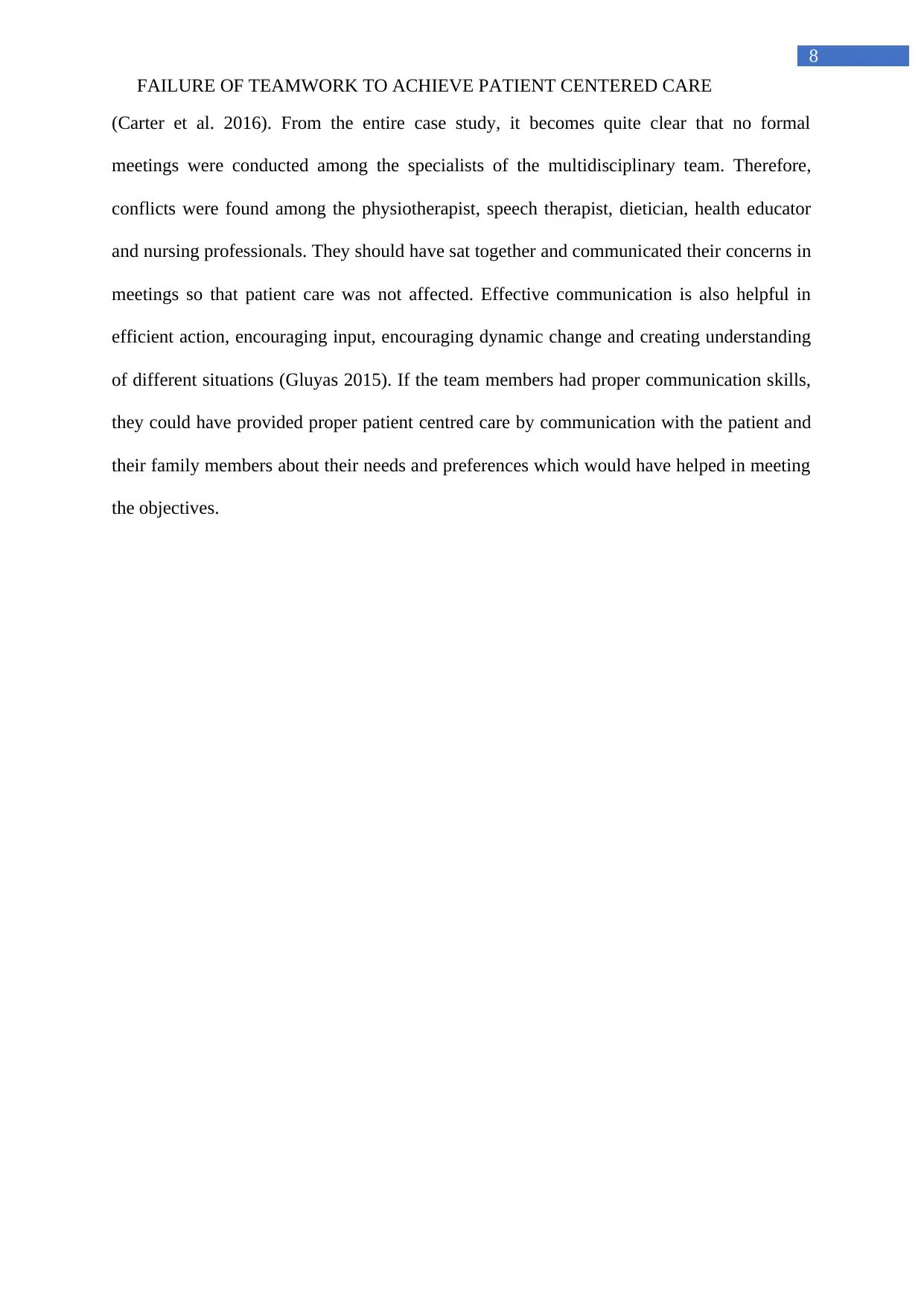
8
FAILURE OF TEAMWORK TO ACHIEVE PATIENT CENTERED CARE
(Carter et al. 2016). From the entire case study, it becomes quite clear that no formal
meetings were conducted among the specialists of the multidisciplinary team. Therefore,
conflicts were found among the physiotherapist, speech therapist, dietician, health educator
and nursing professionals. They should have sat together and communicated their concerns in
meetings so that patient care was not affected. Effective communication is also helpful in
efficient action, encouraging input, encouraging dynamic change and creating understanding
of different situations (Gluyas 2015). If the team members had proper communication skills,
they could have provided proper patient centred care by communication with the patient and
their family members about their needs and preferences which would have helped in meeting
the objectives.
FAILURE OF TEAMWORK TO ACHIEVE PATIENT CENTERED CARE
(Carter et al. 2016). From the entire case study, it becomes quite clear that no formal
meetings were conducted among the specialists of the multidisciplinary team. Therefore,
conflicts were found among the physiotherapist, speech therapist, dietician, health educator
and nursing professionals. They should have sat together and communicated their concerns in
meetings so that patient care was not affected. Effective communication is also helpful in
efficient action, encouraging input, encouraging dynamic change and creating understanding
of different situations (Gluyas 2015). If the team members had proper communication skills,
they could have provided proper patient centred care by communication with the patient and
their family members about their needs and preferences which would have helped in meeting
the objectives.
⊘ This is a preview!⊘
Do you want full access?
Subscribe today to unlock all pages.

Trusted by 1+ million students worldwide
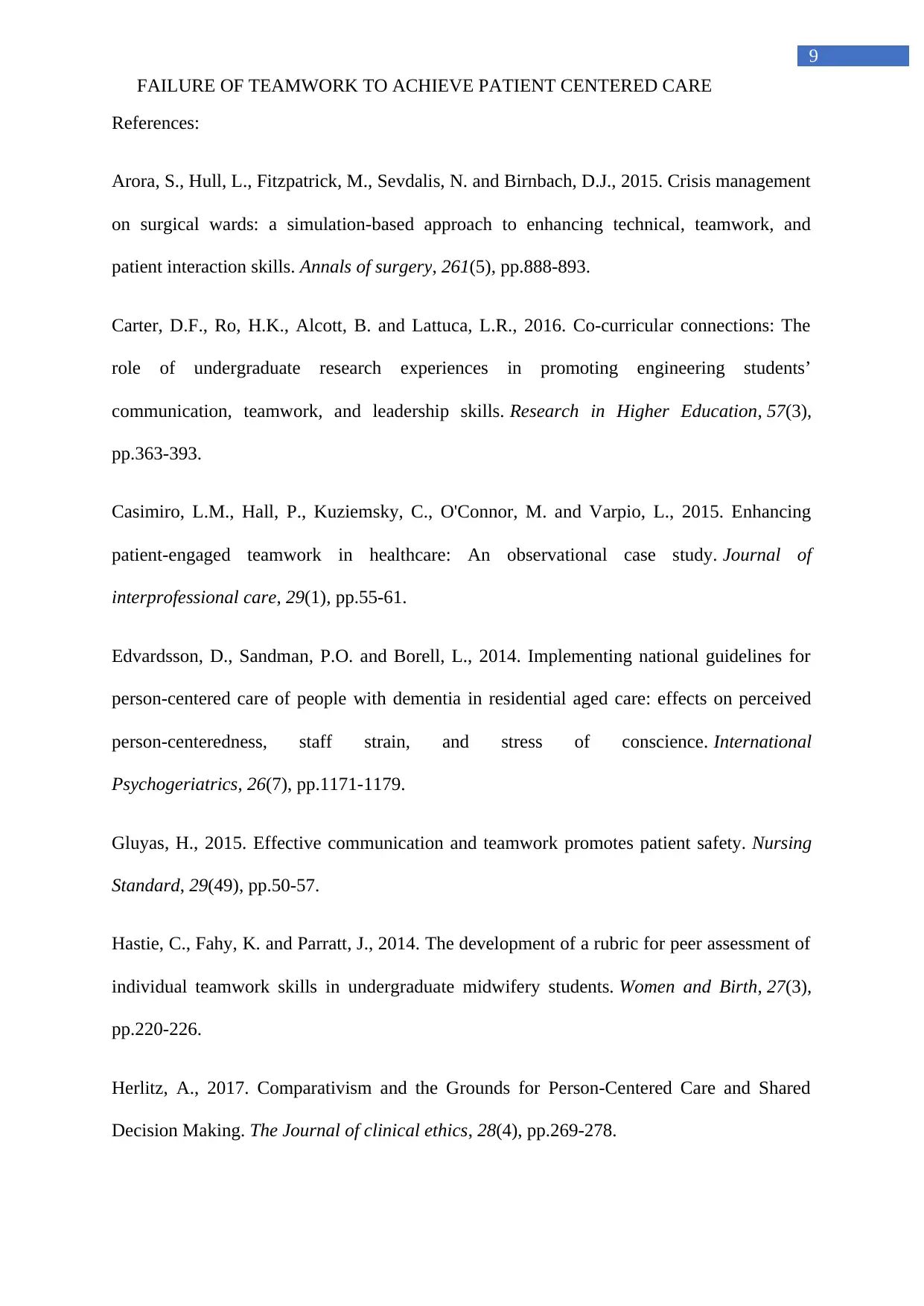
9
FAILURE OF TEAMWORK TO ACHIEVE PATIENT CENTERED CARE
References:
Arora, S., Hull, L., Fitzpatrick, M., Sevdalis, N. and Birnbach, D.J., 2015. Crisis management
on surgical wards: a simulation-based approach to enhancing technical, teamwork, and
patient interaction skills. Annals of surgery, 261(5), pp.888-893.
Carter, D.F., Ro, H.K., Alcott, B. and Lattuca, L.R., 2016. Co-curricular connections: The
role of undergraduate research experiences in promoting engineering students’
communication, teamwork, and leadership skills. Research in Higher Education, 57(3),
pp.363-393.
Casimiro, L.M., Hall, P., Kuziemsky, C., O'Connor, M. and Varpio, L., 2015. Enhancing
patient-engaged teamwork in healthcare: An observational case study. Journal of
interprofessional care, 29(1), pp.55-61.
Edvardsson, D., Sandman, P.O. and Borell, L., 2014. Implementing national guidelines for
person-centered care of people with dementia in residential aged care: effects on perceived
person-centeredness, staff strain, and stress of conscience. International
Psychogeriatrics, 26(7), pp.1171-1179.
Gluyas, H., 2015. Effective communication and teamwork promotes patient safety. Nursing
Standard, 29(49), pp.50-57.
Hastie, C., Fahy, K. and Parratt, J., 2014. The development of a rubric for peer assessment of
individual teamwork skills in undergraduate midwifery students. Women and Birth, 27(3),
pp.220-226.
Herlitz, A., 2017. Comparativism and the Grounds for Person-Centered Care and Shared
Decision Making. The Journal of clinical ethics, 28(4), pp.269-278.
FAILURE OF TEAMWORK TO ACHIEVE PATIENT CENTERED CARE
References:
Arora, S., Hull, L., Fitzpatrick, M., Sevdalis, N. and Birnbach, D.J., 2015. Crisis management
on surgical wards: a simulation-based approach to enhancing technical, teamwork, and
patient interaction skills. Annals of surgery, 261(5), pp.888-893.
Carter, D.F., Ro, H.K., Alcott, B. and Lattuca, L.R., 2016. Co-curricular connections: The
role of undergraduate research experiences in promoting engineering students’
communication, teamwork, and leadership skills. Research in Higher Education, 57(3),
pp.363-393.
Casimiro, L.M., Hall, P., Kuziemsky, C., O'Connor, M. and Varpio, L., 2015. Enhancing
patient-engaged teamwork in healthcare: An observational case study. Journal of
interprofessional care, 29(1), pp.55-61.
Edvardsson, D., Sandman, P.O. and Borell, L., 2014. Implementing national guidelines for
person-centered care of people with dementia in residential aged care: effects on perceived
person-centeredness, staff strain, and stress of conscience. International
Psychogeriatrics, 26(7), pp.1171-1179.
Gluyas, H., 2015. Effective communication and teamwork promotes patient safety. Nursing
Standard, 29(49), pp.50-57.
Hastie, C., Fahy, K. and Parratt, J., 2014. The development of a rubric for peer assessment of
individual teamwork skills in undergraduate midwifery students. Women and Birth, 27(3),
pp.220-226.
Herlitz, A., 2017. Comparativism and the Grounds for Person-Centered Care and Shared
Decision Making. The Journal of clinical ethics, 28(4), pp.269-278.
Paraphrase This Document
Need a fresh take? Get an instant paraphrase of this document with our AI Paraphraser
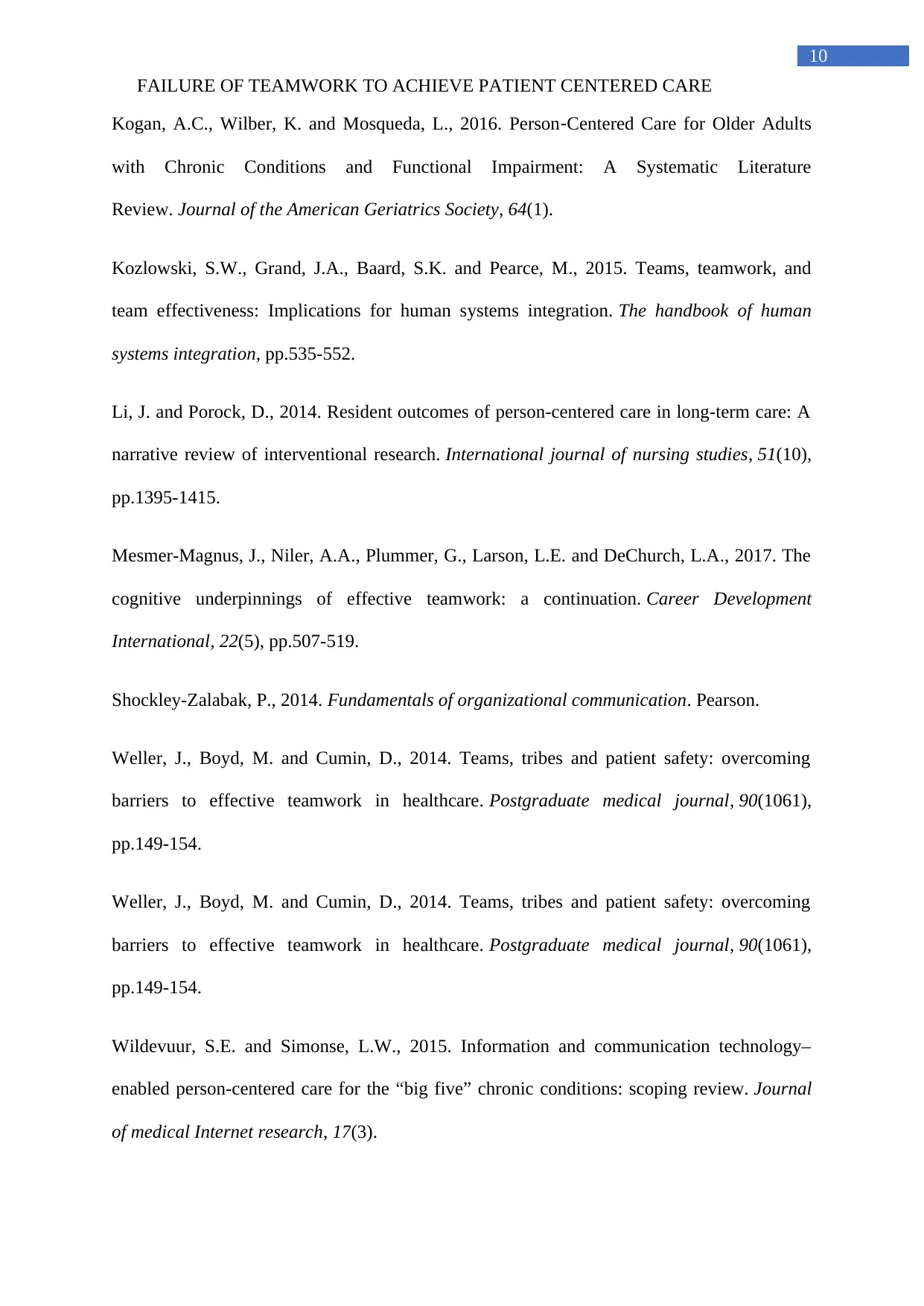
10
FAILURE OF TEAMWORK TO ACHIEVE PATIENT CENTERED CARE
Kogan, A.C., Wilber, K. and Mosqueda, L., 2016. Person‐Centered Care for Older Adults
with Chronic Conditions and Functional Impairment: A Systematic Literature
Review. Journal of the American Geriatrics Society, 64(1).
Kozlowski, S.W., Grand, J.A., Baard, S.K. and Pearce, M., 2015. Teams, teamwork, and
team effectiveness: Implications for human systems integration. The handbook of human
systems integration, pp.535-552.
Li, J. and Porock, D., 2014. Resident outcomes of person-centered care in long-term care: A
narrative review of interventional research. International journal of nursing studies, 51(10),
pp.1395-1415.
Mesmer-Magnus, J., Niler, A.A., Plummer, G., Larson, L.E. and DeChurch, L.A., 2017. The
cognitive underpinnings of effective teamwork: a continuation. Career Development
International, 22(5), pp.507-519.
Shockley-Zalabak, P., 2014. Fundamentals of organizational communication. Pearson.
Weller, J., Boyd, M. and Cumin, D., 2014. Teams, tribes and patient safety: overcoming
barriers to effective teamwork in healthcare. Postgraduate medical journal, 90(1061),
pp.149-154.
Weller, J., Boyd, M. and Cumin, D., 2014. Teams, tribes and patient safety: overcoming
barriers to effective teamwork in healthcare. Postgraduate medical journal, 90(1061),
pp.149-154.
Wildevuur, S.E. and Simonse, L.W., 2015. Information and communication technology–
enabled person-centered care for the “big five” chronic conditions: scoping review. Journal
of medical Internet research, 17(3).
FAILURE OF TEAMWORK TO ACHIEVE PATIENT CENTERED CARE
Kogan, A.C., Wilber, K. and Mosqueda, L., 2016. Person‐Centered Care for Older Adults
with Chronic Conditions and Functional Impairment: A Systematic Literature
Review. Journal of the American Geriatrics Society, 64(1).
Kozlowski, S.W., Grand, J.A., Baard, S.K. and Pearce, M., 2015. Teams, teamwork, and
team effectiveness: Implications for human systems integration. The handbook of human
systems integration, pp.535-552.
Li, J. and Porock, D., 2014. Resident outcomes of person-centered care in long-term care: A
narrative review of interventional research. International journal of nursing studies, 51(10),
pp.1395-1415.
Mesmer-Magnus, J., Niler, A.A., Plummer, G., Larson, L.E. and DeChurch, L.A., 2017. The
cognitive underpinnings of effective teamwork: a continuation. Career Development
International, 22(5), pp.507-519.
Shockley-Zalabak, P., 2014. Fundamentals of organizational communication. Pearson.
Weller, J., Boyd, M. and Cumin, D., 2014. Teams, tribes and patient safety: overcoming
barriers to effective teamwork in healthcare. Postgraduate medical journal, 90(1061),
pp.149-154.
Weller, J., Boyd, M. and Cumin, D., 2014. Teams, tribes and patient safety: overcoming
barriers to effective teamwork in healthcare. Postgraduate medical journal, 90(1061),
pp.149-154.
Wildevuur, S.E. and Simonse, L.W., 2015. Information and communication technology–
enabled person-centered care for the “big five” chronic conditions: scoping review. Journal
of medical Internet research, 17(3).

11
FAILURE OF TEAMWORK TO ACHIEVE PATIENT CENTERED CARE
FAILURE OF TEAMWORK TO ACHIEVE PATIENT CENTERED CARE
⊘ This is a preview!⊘
Do you want full access?
Subscribe today to unlock all pages.

Trusted by 1+ million students worldwide
1 out of 12
Related Documents
Your All-in-One AI-Powered Toolkit for Academic Success.
+13062052269
info@desklib.com
Available 24*7 on WhatsApp / Email
![[object Object]](/_next/static/media/star-bottom.7253800d.svg)
Unlock your academic potential
Copyright © 2020–2025 A2Z Services. All Rights Reserved. Developed and managed by ZUCOL.




